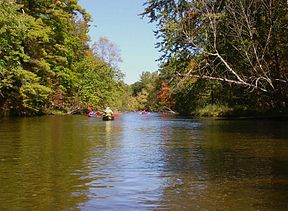Pere Marquette River
| Pere Marquette River | |
| River | |
|
Tourists canoeing on the Pere Marquette River in the Manistee National Forest.
|
|
| Country | United States |
|---|---|
| State | Michigan |
| Counties | Lake, Mason, Newaygo, Oceana |
| Tributaries | |
| - left | Little South Branch, Big South Branch |
| - right | Middle Branch, Baldwin River |
| Cities | Ludington, Scottville |
| Source | |
| - location | Lake County, Michigan, United States |
| - coordinates | 43°51′22″N 85°50′30″W / 43.85611°N 85.84167°W |
| Mouth | Lake Michigan |
| - location | Ludington, Michigan, United States |
| - coordinates | 43°57′06″N 86°27′37″W / 43.95167°N 86.46028°WCoordinates: 43°57′06″N 86°27′37″W / 43.95167°N 86.46028°W |
| Length | 64 mi (103 km) |
| Basin | 740 sq mi (1,917 km2) |
The Pere Marquette River is a river in Michigan in the United States. The main stream of this river is 63.9 miles (102.8 km) long, running from Lake County south of Baldwin into the Pere Marquette Lake, and from there into Lake Michigan.
This river is named after the French Roman Catholic missionary Jacques Marquette, who explored the Great Lakes and Mississippi River areas during the mid-17th century.
The upper portion of the Pere Marquette runs approximately 44 miles (71 km) from the forks of the Little South and Middle Branches downstream to highway M-37. In 1978, 66 miles (106 km) of the river was designated a National Scenic River. This section begins near Baldwin at the junction of the Little South and Middle Branches and continues until the river meets U.S. Highway 31 in Scottville.
The Pere Marquette River is designated a Blue Ribbon fishery.
This river's original native fish was the Grayling, but due to deforestation after the great Chicago Fire, they disappeared from the river. It was then stocked with rainbow trout in 1876. In 1884, the Baldwin River, a major tributary, became the first American river to ever be stocked with European brown trout fish, which were imported from Germany, and is why they are referred to by some as German Brown Trout.
...
Wikipedia


